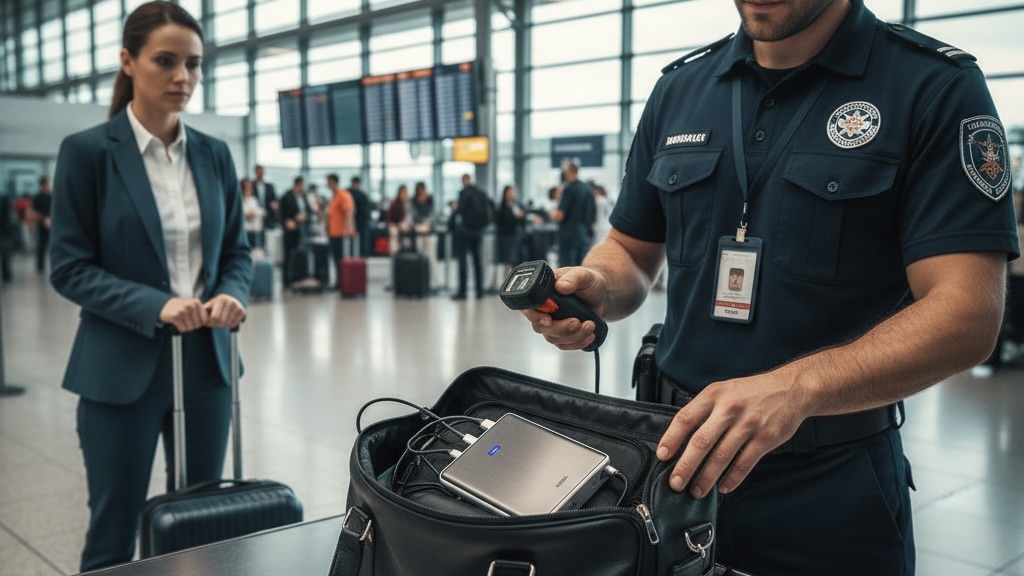Power bank Its use is often prohibited or restricted on airplanes for safety reasons. Although it may seem trivial, this device stores electrical energy in lithium-ion batteries that are highly sensitive to pressure, temperature, and physical damage. In flight, the combination of those factors can trigger a serious risk such as fire or an explosion.
This regulation is globally applicable and is implemented by almost all airlines. Passengers are required to carry a power bank in the cabin, not in checked baggage, and it is prohibited to use it during the flight if the airline prohibits.
risk Thermal Runaway and Fire Hazard
The most dangerous phenomenon of lithium-ion batteries is thermal runawayThis term describes the condition when the battery experiences a rapid increase in extreme temperature due to a short circuit or internal damage.
In a situation like this, the heat generated can trigger fires that are difficult to control. Lithium-ion battery fires also produce toxic gases and thick smoke. In enclosed spaces such as the cabin or the aircraft's baggage compartment, this can be very dangerous because ventilation is limited and the response time is very short.
Cases and Technical Explanations
According to the report The Guardian, thermal runaway May occur due to factors such as pressure, impact, or overcharge. When one battery cell fails, the chemical reactions inside it can trigger a cascading failure to the other cells. This causes a rapid increase in temperature of up to hundreds of degrees Celsius.
Several aviation incidents noted fires from electronic devices as the cause of emergency disruptions, although successfully dealt with using portable fire extinguishers in the cabin.
Airline Protocol Regarding Incidents
Airlines around the world have implemented strict procedures to handle battery fires. The cabin crew are trained to recognize early signs, such as the smell of burning or smoke from the compartments. However, this effort is only effective if the device is in the cabin, not in the baggage.
Why is it not allowed in the trunk?
Many international aviation authorities, including International Air Transport Association (IATA)It prohibits spare batteries or power banks from being in checked baggage. The reason is simple: the aircraft's cargo hold is not directly supervised during flight.
If there is a fire in the cabin, the crew can act immediately. However, if it occurs in cargo, access is closed off and the automatic fire suppression system is not designed to extinguish lithium-ion fires. Therefore, the risk of fire in the baggage compartment is much more dangerous.
Rule Enforcement in Airlines
Airlines such as SWISS Air dan Cathay Pacific They explicitly write in their baggage policy that power banks may only be carried in the cabin. In fact, Cathay Pacific has added a ban on using and storing power banks in the overhead compartments since April 2025.
This policy was adopted after a safety evaluation showed that charging during flight increases the risk of overheating and the potential for sparks.
Consequences of Violations
Passengers who violate this rule may be asked to surrender their power banks before boarding the plane. In certain cases, airport security officers are also entitled to seize devices that are in a damaged condition or have excessively large capacity.
Capacity Limits and Physical Condition of the Power Bank
In addition to the storage location, power bank capacity also a major factor in aviation regulation.
Airlines generally limit the maximum capacity to 100 Wh without special approval. Power banks over 100 Wh up to 160 Wh can be carried with airline permission, while anything above that is usually prohibited altogether.
Examples of airline and manufacturer standards
Manufacturers such as Anchor Writing an official guide on capacity calculation (Wh = Volt × Ampere-hour ÷ 1000). High-capacity power banks for laptops usually exceed 100 Wh, so users need to ensure the capacity complies with airline limits.
In addition, the physical condition of the device is also checked. A power bank with signs of damage, swelling, or loose cables may be considered high risk and be refused by security officers.
The importance of pre-flight checks.
Before traveling, it is recommended to check the power bank's specification label and ensure there is no physical damage. Avoid the use of unofficial adapters that could cause a current surge. This simple inspection can prevent major problems at the airport or in the air.
Charging During Flight
Some airlines allow the use of power banks to charge personal devices during flights, but most Prohibits direct charging using a power bank.
Stricter airline rules
Cathay Pacific, for example, has imposed a ban on the use of power banks and on storing them in the overhead bins since April 2025. This step was taken after several reports of excessive heat during air charging.
Airlines assess that cabin space at a certain pressure and temperature can increase chemical reactions in batteries. Charging also increases the risk of overcurrent in devices that have been in use for a long time.
Risk of Cabin Pressure and Temperature.
The aviation environment is very different from the conditions on land. Low air pressure and unstable temperatures can affect the chemical reactions in lithium-ion batteries. If a heat spike occurs, energy is difficult to dissipate because the thin air slows the cooling process.
Therefore, the use of power banks on airplanes is often restricted to emergency situations and under strict supervision by the cabin crew.
Regulations and Passenger Education
Aviation safety has always been the top priority. Therefore, many airports are now tightening security checks on electronic devices that use lithium-ion batteries.
Passenger education by the Aviation Authority
Some countries even implement specialized safety education programs. Posters and announcements in the airport area explain that power banks must be carried in the cabin, may not be in checked baggage, and may not be used during the flight if the airline prohibits.
Collaboration between airlines and manufacturers.
Power bank manufacturers also work with aviation authorities to create safer designs, such as automatic circuit-breaker systems and temperature sensors. These steps aim to reduce risk. thermal runaway without sacrificing power performance.
Overall, the ban on bringing power bank in the airplane's checked baggage It is not merely a trivial rule, but a very important safety measure. Lithium-ion batteries are indeed efficient, but they have a high potential for danger in extreme conditions such as flight.
Bringing a power bank in the cabin, ensuring its capacity complies with regulations, and not using it during the flight, is a form of passenger responsibility for the safety of everyone on board.
Discover more from Insimen
Subscribe to get the latest posts sent to your email.










